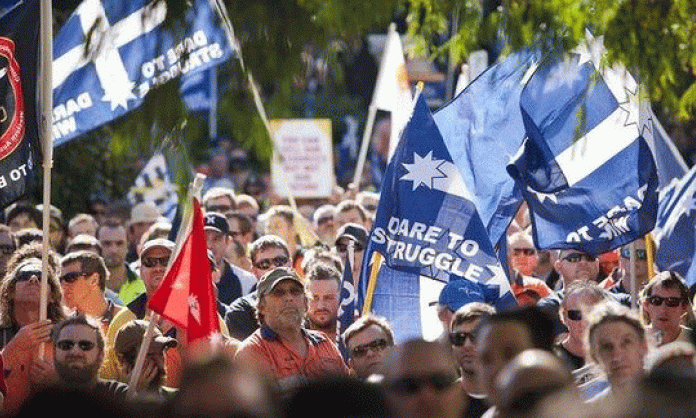Liberating top politicians from external constraints is the goal of Bill Shorten’s proposals for minor organisational changes in the ALP. The issue is not union bureaucrats versus rank and file party members.
Since the mid-1890s, the ALP has been a workers’ party committed to managing the bosses’ system. Over the long term, however, Labor has been proposing ever fewer policies that bosses might dislike. Party leaders have grown accustomed to satisfying the needs of big business and top public servants. They have become increasingly adept at calculating when the needs of their working class supporters have to be butchered.
The rabid Murdoch media and Financial Review pretend to be horrified at the ALP’s actions and record. But sober corporate managers know they can do business with Labor governments.
Labor once had a devoted working class electoral base, a large, active working class membership and the resources of affiliated trade unions.
Erosion of support
Today the proportion of Labor voters who are workers is still significantly higher than is the case for the Liberal and National parties. But over a long period, the WD40 of Labor’s attacks has loosened its previously rusted-on working class voters. The ALP’s performance in the recent Senate election rerun in Western Australia, just 22 percent, is the worst since before World War I.
As ALP insiders such as former federal leader Mark Latham and former NSW minister Rodney Cavalier have noted, local Labor Party branches have been hollowed out. Once an integral part of working class communities, most are now dominated by small numbers of professional politicians, their families, staffers and hangers-on, full time union officials and those hungry for a career in public office.
The key to winning back a working class electoral base would be fighting for policies that deliver large benefits for workers. Instead of pandering to elite private schools, medical corporations and the budget fetishes of the wealthy, pro-working class policies would expand spending on public schools and public health care, funded by taxes on the rich and big business.
They would include laws that make it easier for workers to fight for better pay and conditions. And they would promote a spirit of solidarity, with the party mobilising its members and resources to back workers’ and union struggles, rather than staying aloof or denouncing them.
Instead, Shorten’s reforms simply reinforce the Abbott government’s efforts to smear unions as corrupt and irresponsible. They are about distancing his party from the union movement.
Dropping the requirement that people eligible to be union members must be union members before they join the ALP is an important symbolic step. Symbolic because the rule has not generally been enforced; important because it tells scabs that they are welcome in the party.
The “‘one-click’ online joining model” for ALP membership that Shorten has decreed may well expand the passive, largely inactive membership of the party. That will help reduce union influence over the selection of Labor candidates.
Union officials and top politicians have been the two main centres of power in the ALP. There has always been some tension between them.
Union officials
On one hand, union officials are engaged in the important, never-ending and ultimately hopeless task of reconciling the interests of workers with capitalism. They are pressured from below to improve the conditions under which their members are exploited. They are pressured from above to be reasonable in the eyes of bosses, governments and senior public servants.
Particularly under their influence, Labor has sometimes introduced measures that improve things for workers. On the other hand, union leaders have also played a crucial role in helping Labor implement policies that damage workers’ interests. For example, they endorsed the sacrifices for the “war effort” imposed on workers by Labor leaders Jack Curtin and Ben Chifley, and were the mainstay of the wage-cutting Accord under Bob Hawke and Paul Keating, during the 1980s and 1990s.
Nevertheless, inside the ALP they are an indirect link to the working class.
The politicians, who are more integrated into the machinery of government, resent limits on their ability to decide what is best for the party and the country.
The decline in the proportion of workers who belong to unions and lower levels of industrial militancy have reduced the weight of officials in the party and their usefulness to politicians in controlling the working class. New campaign technologies and public funding of mainstream parties have also made politicians less dependent on union resources.
But the strength of the union officials in the party is still grounded in the ALP’s rules. So leaders of the parliamentary Labor Party have had to be patient in efforts to increase their power at the expense of the secretaries of affiliated unions.
The politicians’ efforts have been bolstered by electoral defeats and the recent fiasco of Western Australian Labor senator-elect Joe Bullock, the bigoted denigrator of his own party and its members.
Involving party members in the elections of leaders is another way of reducing union influence in the ALP, through parliamentary factions in the caucuses. At present most of the delegates to Labor’s national conference are elected by state conferences. Direct rank and file election of delegates will increase the clout of the full time politicians at the expense of union officials.
Those demanding “modernisation” want a party like the Democrats in the United States. Shorten’s reforms reinforce the long term trend towards such a party, in which union officials have minimal influence but union funds are gratefully received, and party leaders don’t need to spend much time justifying their actions when they sink the boot into workers.
[Rick Kuhn is co-author of Labor’s Conflict: big business, workers and the politics of class.]





